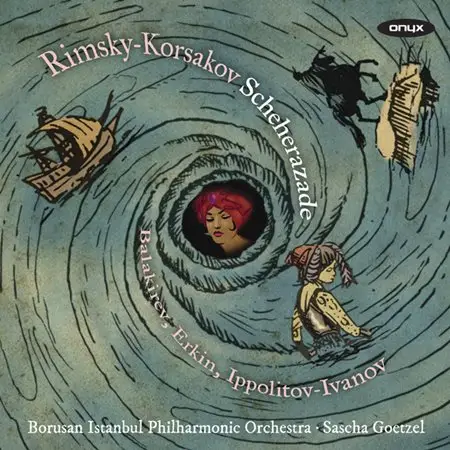Goetzel, Borusan Istanbul Philharmonic - Rimsky-korsakov: Scheherezade; Balakirev: Islamey (2014)
FLAC (tracks) 24 bit/96 kHz | Digital Booklet | 1.47 GB
Genre: Classical | Official Digital Download - Source: HDtracks
FLAC (tracks) 24 bit/96 kHz | Digital Booklet | 1.47 GB
Genre: Classical | Official Digital Download - Source: HDtracks
Since it was founded, the Borusan Istanbul Philharmonic Orchestra has worked to develop not only as a symphony orchestra but as a showcase for music from different traditions – a multicultural mosaic where each little stone is carefully placed with the utmost respect for its neighbour, making a unique contribution to its surroundings. Our first two CDs have reflected this, combining music of composers from different backgrounds with a similar musical language. We now embark on another exploration of the eastern musical roots of Europe in the late 19th and first half of the 20th century, identifying elements of the eastern side of the Bosphorus which have influenced the Western cultural background of most of these composers.
Composer: Nikolai Rimsky-Korsakov, Mily Balakirev, Mikhail Ippolitov-Ivanov, Ulvi Cemal Erkin
Performer: Pelin Halkaci
Conductor: Sascha Goetzel
Reviews: As Bernhard-Henri Lévy puts it, ‘Europe has developed more as an idea than as an area.’ Influence on European culture extends much further east than many of us realise. Music and art transcend borders, regardless of cultural background or political history. Our musical journey sets out from St Petersburg and travels down to the Black Sea, over the Caucasus and eastern Turkey all the way to Istanbul. By partly using original instruments from those regions we have created a musical language which I think is closer to the original sound that the composers had in mind when writing their music for Western-style orchestras.
Nikolai Rimsky-Korsakov’s Scheherazade has fascinated listeners ever since its premiere in 1888 – one of the most exotic, colourful and enchanting compositions of its time. The recording presented us with the challenge of finding new ways to the Oriental narrative Rimsky-Korsakov envisaged, and to bridge the gap between ancient East and contemporary West. For the first time ever we introduce original Oriental instruments on a Scheherazade recording. Between the first and second movements the oud plays a traditional melody, setting the atmosphere and recalling the magic and drama of the Tales of 1001 Nights, the story of Scheherazade’s plan to keep Sultan Shahryar from his murderous intentions by telling him a spellbinding story night after night, the Sultan keeping her alive in eager anticipation of the end of the tale.
The work is based on the symphonic model with some of the first movement’s major themes serving as musical cells for the other movements’s melodies. The composer insisted that there was no absolute programme to the music: his inspiration from the Arabian Nights, however, is unmistakable. In our recording, the violin solo recitatives, which represents Princess Scheherazade, is accompanied by the qanun instead of the harp. Throughout the work a variety of traditional Turkish and Arabian percussion instruments are delicately incorporated to support Rimsky-Korsakov’s Arabic rhythm writing: the darbuka, def, bendir and kudüm as well as oriental triangles and cymbals underpin his ‘kaleidoscope of fairy-tale images’. Between the third and fourth movements the qanun plays another traditional melody bridging ancient musical traditions and modern western tonal music.
Mily Alexeyevich Balakirev’s composition Islamey (1869; subtitled ‘Oriental Fantasy’) op.18 is one of the most virtuosic compositions for piano solo. The inspiration for this spectacular and exotic piece came, as with Ippolitov-Ivanov, after a trip to the Caucasus region. It is divided into three sections consisting of two strongly contrasting themes. While the first is highly energetic and rhythmic, the second is melodic and colourful, introduced by the cellos in a gently moving 6/8 pattern reminiscent of the third movement of Scheherazade. In a letter to his friend Eduard Reiss (1892) Balakirev described the impressions on which the work is based:
‘… the majestic beauty of luxuriant nature there and the beauty of the inhabitants that harmonizes with it – all these things together made a deep impression on me … Since I was interested in the vocal music there, I made the acquaintance of a Circassian prince, who frequently came to me and played folk tunes on his instrument, that was something like a violin. One of them, called Islamey, a dance tune, pleased me extraordinarily, and with a view to the work I had in mind for Tamara I began to arrange it for the piano. The second theme was communicated to me in Moscow by an Armenian actor, who came from the Crimea and is, as he assured me, well known among the Crimean Tatars.’
Islamey had a considerable influence on composers of the late 19th century. Maurice Ravel stated that his goal in writing Gaspard de la nuit was to compose a piece that was ‘more difficult than Balakirev’s Islamey’. Alexander Borodin included quotations in his opera Prince Igor and Rimsky-Korsakov did the same in Scheherazade. It has twice been arranged for orchestra, by Alfredo Casella and by Sergei Lyapunov. We chose Lyapunov’s, who was the most important member of Balakirev’s circle. Balakirev took Lyapunov under his wing and remained his major creative influence.
Mikhail Ippolitov-Ivanov was a student of Rimsky-Korsakov at the St Petersburg conservatory. His first major appointment was as music director and conductor in Tbilisi, where he became acquainted with Georgian folk music. His Caucasian Sketches acknowledge the rich cultural diversity and uniqueness of the inhabitants of the mountain region, which extend into the arts and musical language – European one moment, exotic and oriental the next. Ippolitov-Ivanov combines regional folk tunes with brilliant orchestration. The first Suite consists of four separate unconnected sketches. We decided to record two very contrasting ones:
In a Village: The original orchestration asks for the cor anglais to play an exotic tune in imitation of the native region’s Zurna. We couldn’t find a Zurna to match the tuning of a modern symphony orchestra, so we compromised with a Ney flute to represent a close original sound. There are different sizes of Ney flutes for higher and lower registers; we chose a bigger flute to match the special tonal colour of the cor anglais.
Procession of the Sardar: The final movement of the Suite and certainly the most popular. We use many traditional percussion instruments including piccolo timpani throughout the whole piece. The title ‘Sardar’ occurs in several Eastern languages such as Persian and Hindi, and means a military commander, leader or dignitary.
Ulvi Cemal Erkin (1906–1972) was a member of the ‘Turkish Five’ group of composers, who used Turkish folk music in a Western symphonic style, encouraged by Atatürk in the development of the newly founded republic which aimed to modernize and westernize industry, agriculture and art. Erkin studied in Paris with Nadia Boulanger, and his Köçekçe: Dance Rhapsody for Orchestra (1943) is probably his most popular work. It contains allusions to a traditional men’s dance and reflects the harmonies, melodies and rhythms of Turkish music within a western framework.
Tracklisting:
NIKOLAI RIMSKY-KORSAKOV (1844–1908) - Scheherazade op.35
1 I The Sea and Sinbad’s Ship (Largo e maestoso — Lento — Allegro non troppo — Tranquillo) 10.15
2 Oud introduction 0.48
3 II The Kalendar Prince (Lento — Andantino — Allegro molto — Vivace scherzando — Moderato assai — Allegro molto ed animato) 13.03
4 III The Young Prince and The Young Princess (Andantino quasi allegretto — Pochissimo più mosso — Come prima — Pochissimo più animato) 10.59
5 Qanun introduction 0.17
6 IV Festival at Baghdad. The Sea. The ship breaks against a cliff surmounted by a bronze horseman. (Allegro molto — Lento — Vivo — Allegro non troppo e maestoso — Tempo come I) 12.31
MILY BALAKIREV (1837–1910) - Islamey – Oriental fantasy, op.18
7 Allegro agitato – Tranquillo – Andantino espressivo – Allegro vivo – Presto furioso 8.54
MIKHAIL IPPOLITOV-IVANOV (1859–1935) - Caucasian Sketches – Suite no.1 (1894)
8 No.2 – In a Village 6.22
9 No.4 – Procession of the Sardar 3.50
ULVI CEMAL ERKIN (1906–1972)
10 Köçekçe, dance rhapsody for orchestra (1943) 9.47
Bonus Tracks:
NIKOLAI RIMSKY-KORSAKOV (1844–1908)
11 Scheherezade, Op. 35: II. The Story of the Kalendar Prince (Alternative Version) 2.11
12 Caucasian Sketches, Suite No. 1, Op. 10: II. In the Village (Alternative Version) 6.20
foobar2000 1.0.1 / Dynamic Range Meter 1.1.1
log date: 2014-09-02 23:53:09
––––––––––––––––––––––––––––––––––––––––
Analyzed: Borusan Istanbul Philharmonic Orchestra, Sascha Goetzel, Pelin Halkacı Alkın / Rimsky-Korsakov: Scheherezade, Op. 35 (1-8)
Borusan Istanbul Philharmonic Orchestra, Sascha Goetzel / Rimsky-Korsakov: Scheherezade, Op. 35 (9-12)
––––––––––––––––––––––––––––––––––––––––
DR Peak RMS Duration Track
––––––––––––––––––––––––––––––––––––––––
DR12 -0.20 dB -17.31 dB 10:15 01-Scheherezade, Op. 35: I. The Sea and Sinbad's Ship
DR14 -16.74 dB -38.61 dB 0:48 02-Improvisation for Oud
DR15 -0.20 dB -21.02 dB 13:04 03-Scheherezade, Op. 35: II. The Story of the Kalendar Prince
DR16 -1.78 dB -23.54 dB 11:00 04-Scheherezade, Op. 35: III. The Young Prince and the Young Princess
DR11 -24.49 dB -43.03 dB 0:17 05-Improvisation for Kanon
DR11 -0.20 dB -17.14 dB 12:42 06-Scheherezade, Op. 35: IV. The Festival of Bagdad, The Sea, The Ship Goes to Places on a Rock Surmounted by a Bronze Warrior
DR10 -15.43 dB -31.21 dB 2:11 11-Scheherezade, Op. 35: II. The Story of the Kalendar Prince (Alternative Version) [Bonus Track]
DR15 -5.86 dB -26.90 dB 6:21 12-Caucasian Sketches, Suite No. 1, Op. 10: II. In the Village (Alternative Version) [Bonus Track]
DR15 -0.20 dB -19.69 dB 9:01 07-Islamey - Oriental Fantasy, Op. 18
DR13 -9.94 dB -28.96 dB 6:22 08-Caucasian Sketches, Suite No. 1, Op. 10: II. In a Village
DR13 -0.20 dB -18.44 dB 3:58 09-Caucasian Sketches, Suite No. 1, Op. 10: IV. Procession of the Sardar
DR13 -0.20 dB -17.62 dB 9:48 10-Kocekce, Dance Rhapsody for Orchestra
––––––––––––––––––––––––––––––––––––––––
Number of tracks: 12
Official DR value: DR13
Samplerate: 96000 Hz
Channels: 2
Bits per sample: 24
Bitrate: 2626 kbps
Codec: FLAC
================================================================================
log date: 2014-09-02 23:53:09
––––––––––––––––––––––––––––––––––––––––
Analyzed: Borusan Istanbul Philharmonic Orchestra, Sascha Goetzel, Pelin Halkacı Alkın / Rimsky-Korsakov: Scheherezade, Op. 35 (1-8)
Borusan Istanbul Philharmonic Orchestra, Sascha Goetzel / Rimsky-Korsakov: Scheherezade, Op. 35 (9-12)
––––––––––––––––––––––––––––––––––––––––
DR Peak RMS Duration Track
––––––––––––––––––––––––––––––––––––––––
DR12 -0.20 dB -17.31 dB 10:15 01-Scheherezade, Op. 35: I. The Sea and Sinbad's Ship
DR14 -16.74 dB -38.61 dB 0:48 02-Improvisation for Oud
DR15 -0.20 dB -21.02 dB 13:04 03-Scheherezade, Op. 35: II. The Story of the Kalendar Prince
DR16 -1.78 dB -23.54 dB 11:00 04-Scheherezade, Op. 35: III. The Young Prince and the Young Princess
DR11 -24.49 dB -43.03 dB 0:17 05-Improvisation for Kanon
DR11 -0.20 dB -17.14 dB 12:42 06-Scheherezade, Op. 35: IV. The Festival of Bagdad, The Sea, The Ship Goes to Places on a Rock Surmounted by a Bronze Warrior
DR10 -15.43 dB -31.21 dB 2:11 11-Scheherezade, Op. 35: II. The Story of the Kalendar Prince (Alternative Version) [Bonus Track]
DR15 -5.86 dB -26.90 dB 6:21 12-Caucasian Sketches, Suite No. 1, Op. 10: II. In the Village (Alternative Version) [Bonus Track]
DR15 -0.20 dB -19.69 dB 9:01 07-Islamey - Oriental Fantasy, Op. 18
DR13 -9.94 dB -28.96 dB 6:22 08-Caucasian Sketches, Suite No. 1, Op. 10: II. In a Village
DR13 -0.20 dB -18.44 dB 3:58 09-Caucasian Sketches, Suite No. 1, Op. 10: IV. Procession of the Sardar
DR13 -0.20 dB -17.62 dB 9:48 10-Kocekce, Dance Rhapsody for Orchestra
––––––––––––––––––––––––––––––––––––––––
Number of tracks: 12
Official DR value: DR13
Samplerate: 96000 Hz
Channels: 2
Bits per sample: 24
Bitrate: 2626 kbps
Codec: FLAC
================================================================================
Thanks to the original customer



